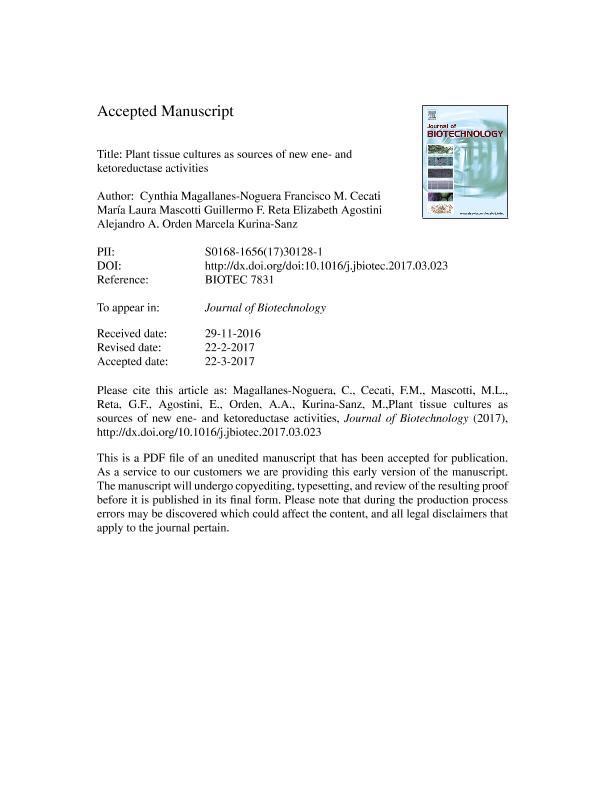Artículo
Plant tissue cultures as sources of new ene- and ketoreductase activities
Magallanes Noguera, Cynthia Alejandra ; Cecati, Francisco Miguel
; Cecati, Francisco Miguel ; Mascotti, María Laura
; Mascotti, María Laura ; Reta, Guillermo Federico
; Reta, Guillermo Federico ; Agostini, Elizabeth
; Agostini, Elizabeth ; Orden, Alejandro Agustin
; Orden, Alejandro Agustin ; Kurina Sanz, Marcela Beatriz
; Kurina Sanz, Marcela Beatriz
 ; Cecati, Francisco Miguel
; Cecati, Francisco Miguel ; Mascotti, María Laura
; Mascotti, María Laura ; Reta, Guillermo Federico
; Reta, Guillermo Federico ; Agostini, Elizabeth
; Agostini, Elizabeth ; Orden, Alejandro Agustin
; Orden, Alejandro Agustin ; Kurina Sanz, Marcela Beatriz
; Kurina Sanz, Marcela Beatriz
Fecha de publicación:
06/2017
Editorial:
Elsevier Science
Revista:
Journal of Biotechnology
ISSN:
0168-1656
Idioma:
Inglés
Tipo de recurso:
Artículo publicado
Clasificación temática:
Resumen
While many redox enzymes are nowadays available for synthetic applications, the toolbox of ene-reductases is still limited. Consequently, the screening for these enzymes from diverse sources in the search of new biocatalyst suitable for green chemistry approaches is needed. Among 13 plant tissue cultures, Medicago sativa and Tessaria absinthioides calli, as well as Capsicum annuum hairy roots, were selected due to their ability to hydrogenate the C[dbnd]C double bond of the model substrate 2-cyclohexene-1-one. The three axenic plant cultures showed more preference toward highly activated molecules such as nitrostyrene and maleimide rather than the classical substrates of the well-known Old Yellow Enzymes, resembling the skills of the NAD(P)H-dependent flavin-independent enzymes. When the three biocatalytic systems were applied in the reduction of chalcones, T. absinthioides showed high chemoselectivity toward the C[dbnd]C double bond whereas the other two demonstrated abilities to biohydrogenate the C[dbnd]C double bounds and the carbonyl groups in a sequential fashion.
Archivos asociados
Licencia
Identificadores
Colecciones
Articulos(IMIBIO-SL)
Articulos de INST. MULTIDICIPLINARIO DE INV. BIO. DE SAN LUIS
Articulos de INST. MULTIDICIPLINARIO DE INV. BIO. DE SAN LUIS
Articulos(INTEQUI)
Articulos de INST. DE INVEST. EN TECNOLOGIA QUIMICA
Articulos de INST. DE INVEST. EN TECNOLOGIA QUIMICA
Citación
Magallanes Noguera, Cynthia Alejandra; Cecati, Francisco Miguel; Mascotti, María Laura; Reta, Guillermo Federico; Agostini, Elizabeth; et al.; Plant tissue cultures as sources of new ene- and ketoreductase activities; Elsevier Science; Journal of Biotechnology; 251; 6-2017; 14-20
Compartir
Altmétricas



